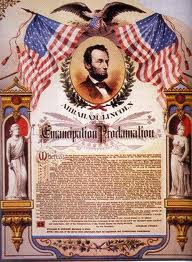Black History Month Provides an Opportunity to Remember the Dreams of Those Who Came Before Us
Black History Month 2013 recognizes two important anniversaries in the evolution of civil rights in the United States. The theme this year is “At the Crossroads of Freedom and Equality: The Emancipation Proclamation and the March on Washington.”
Issued on January 1, 1863, Lincoln’s renowned proclamation reads in part:
That on the first day of January, in the year of our Lord one thousand eight hundred and sixty-three, all persons held as slaves within any State or designated part of a State, the people whereof shall then be in rebellion against the United States, shall be then, thenceforward, and forever free; and the Executive Government of the United States, including the military and naval authority thereof, will recognize and maintain the freedom of such persons, and will do no act or acts to repress such persons, or any of them, in any efforts they may make for their actual freedom.
According to the Oxford English Dictionary (OED), a proclamation is “a formal order issued by a monarch or other legal authority, and made public.” In reading the above excerpt, one can certainly draw the conclusion that President Lincoln met the OED’s criteria for a proclamation; it is indeed dry, formal, official, and reveals none of the soul searching that went into its writing.
Compare Lincoln’s document with the words of Dr. Martin Luther King, Jr. spoken August 28, 1963 during the March on Washington:
I have a dream that one day every valley shall be exalted, every hill and mountain shall be made low, the rough places will be made plain, and the crooked places will be made straight, and the glory of the Lord shall be revealed, and all flesh shall see it together.
This is our hope. This is the faith with which I return to the South. With this faith we will be able to hew out of the mountain of despair a stone of hope. With this faith we will be able to transform the jangling discords of our nation into a beautiful symphony of brotherhood. With this faith we will be able to work together, to pray together, to struggle together, to go to jail together, to stand up for freedom together, knowing that we will be free one day.
Dr. King’s speech is peppered with biblical allusions and poetic constructions. Whereas Lincoln’s proclamation is a law for American courts and legislative bodies, King’s speech is a dream for mankind. But the pursuit of freedom demands both rousing speeches and dry laws. What all of us sometime forget is that for dreams to remain alive, students and citizens of all ages must study the past thoughts, deeds, and words of leaders like President Lincoln and Dr. King.
For those interested in pursuing such an endeavor, the Birmingham Public Library can provide a wealth of resources. We have books, DVDs, audiobooks, and computer databases that focus on African-Americans and African-American history. If you are not sure where to begin your study, you may want to get some direction by consulting our subject guide for African American History Month. Here you can find frequently requested African-American book titles, as well as extensive annotated lists of reference books, databases, magazines and newspapers, and internet websites.
The library’s databases deserve special mention. You don’t even have to leave your house to use them. Just grab your library card and visit www.bplonline.org, and click on “Databases.” Notice under “Subject List,”on the left hand side of the page, the term “African American.” Of the three databases included, my favorite is African-American History Online. The developers of this database have put together an impressive array of information that includes biographies, timelines, and articles covering the African-American experience. On the front page is a heading for Topic Centers that groups the databases’ material according to important events and topics, primary sources, and key people. For instance, “1955-1971 Civil Rights Protest and Progress” will lead you to a piece about the Birmingham demonstrations, Malcolm X, and a copy of Dr. King’s "I Have a Dream" speech.
This database even has a tab, Images and Videos, perfect for homework assignments. (I don’t have homework assignments and this is still my favorite feature). For a sampling, click on “Go to Video Gallery” on the right hand side of the front screen. On the next screen you can watch a video of Angela Davis being interviewed in Moscow, African American soldiers drilling for combat during W.W.II, or Dr. King marching with demonstrators in Selma, Alabama.
But don’t limit your search to just one of the library’s databases. Many figures from African American history can also be found by clicking on “Biography” in the “Subject List” of databases. Biography in Context has more than one million historic and current figures. There is also a featured video section on this database. This month in honor of Black History Month, you can watch a video highlighting the artists and writers of the Harlem Renaissance.
So, in February (and all year long), log on to www.bplonline.org to learn more about African-American history. Keep the dreams of those who came before us alive and growing by reading their words and viewing their deeds.
Submitted by David Ryan
Business, Science and Technology Department


Comments